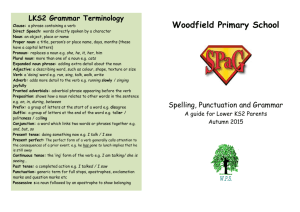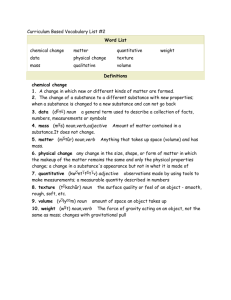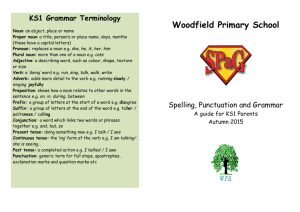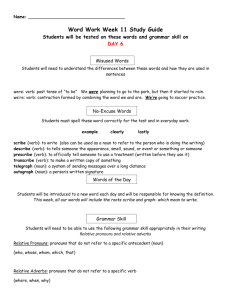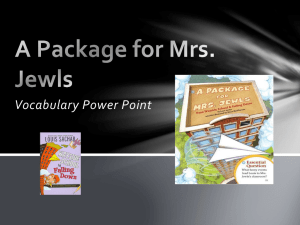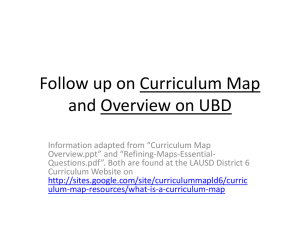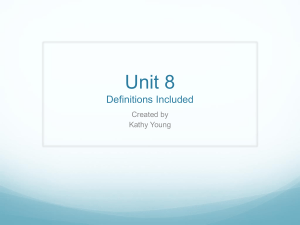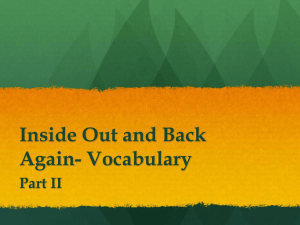Upper Key Stage 2
advertisement
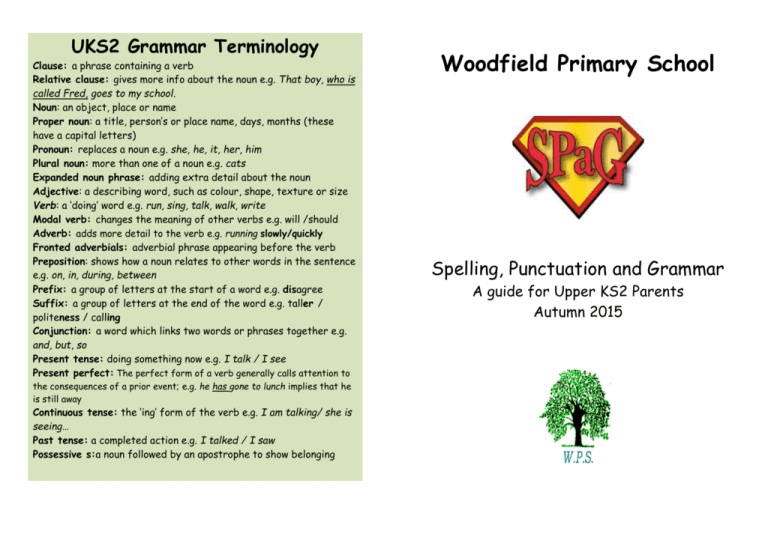
UKS2 Grammar Terminology Clause: a phrase containing a verb Relative clause: gives more info about the noun e.g. That boy, who is called Fred, goes to my school. Noun: an object, place or name Proper noun: a title, person’s or place name, days, months (these have a capital letters) Pronoun: replaces a noun e.g. she, he, it, her, him Plural noun: more than one of a noun e.g. cats Expanded noun phrase: adding extra detail about the noun Adjective: a describing word, such as colour, shape, texture or size Verb: a ‘doing’ word e.g. run, sing, talk, walk, write Modal verb: changes the meaning of other verbs e.g. will /should Adverb: adds more detail to the verb e.g. running slowly/quickly Fronted adverbials: adverbial phrase appearing before the verb Preposition: shows how a noun relates to other words in the sentence e.g. on, in, during, between Prefix: a group of letters at the start of a word e.g. disagree Suffix: a group of letters at the end of the word e.g. taller / politeness / calling Conjunction: a word which links two words or phrases together e.g. and, but, so Present tense: doing something now e.g. I talk / I see Present perfect: The perfect form of a verb generally calls attention to the consequences of a prior event; e.g. he has gone to lunch implies that he is still away Continuous tense: the ‘ing’ form of the verb e.g. I am talking/ she is seeing… Past tense: a completed action e.g. I talked / I saw Possessive s:a noun followed by an apostrophe to show belonging Woodfield Primary School Spelling, Punctuation and Grammar A guide for Upper KS2 Parents Autumn 2015 Dear Parents, Spelling, Punctuation and Grammar (SPaG) is now tested nationally in Year Two and in Year Six. At the end of each key stage, all children will be assessed on their ability to recall their knowledge and understanding in these areas so it is vital that we work together to prepare them for this. Quality teaching of SPaG in school and your support with the extension tasks set as homework, will give your child the best possible chance of success. For your child to do well in the SPaG tests, they don’t just have to be good at writing; they also need a technical understanding of how the English language works, including the correct grammatical terminology appropriate to their year group. We understand that supporting your child with learning SPaG can be challenging so we hope you will find this reference and glossary helpful and keep it to help you support your child with their learning. What’s changed in the new curriculum? The revised National Curriculum for English places a much stronger emphasis on vocabulary development, grammar, punctuation and spelling. Expectations have been raised in each year group with many aspects having to be taught at least a year earlier than in the previous curriculum. *Please note that children are expected to be secure in the previous year’s objectives as well as their own. New curriculum expectations New curriculum in Year 5 expectations in Year 6 • Converting nouns or adjectives into verbs using suffixes e.g.–ate; –ise; – ify • Verb prefixes e.g. dis–, de–, mis– , over– and re– • Relative clauses beginning with who, which, where, when, whose, that, or an omitted relative pronoun • Indicating degrees of possibility using adverbs e.g. perhaps or modal verbs e.g. might • Devices to build cohesion within a paragraph e.g. then • Linking ideas across paragraphs using adverbials of time e.g. later, place e.g. nearby and number e.g. secondly or tense choices e.g. he had seen her before • Brackets, dashes or commas to indicate parenthesis • Use of commas to clarify meaning or avoid ambiguity • Use of the passive to affect the presentation of information in a sentence e.g. I broke the window in the greenhouse versus The window in the greenhouse was broken • Use of subjunctive forms such as If I were or Were they to come in some very formal writing and speech • A wider range of cohesive devices: repetition of a word or phrase, grammatical connections e.g. the use of adverbials such as on the other hand and ellipsis • Use of the semi-colon, colon and dash to mark the boundary between independent clauses e.g. It’s raining; I’m fed up, use of the colon to introduce a list and use of semi-colons within lists and how hyphens can be used to avoid ambiguity recover versus re-cover • Punctuation of bullet points to list information
